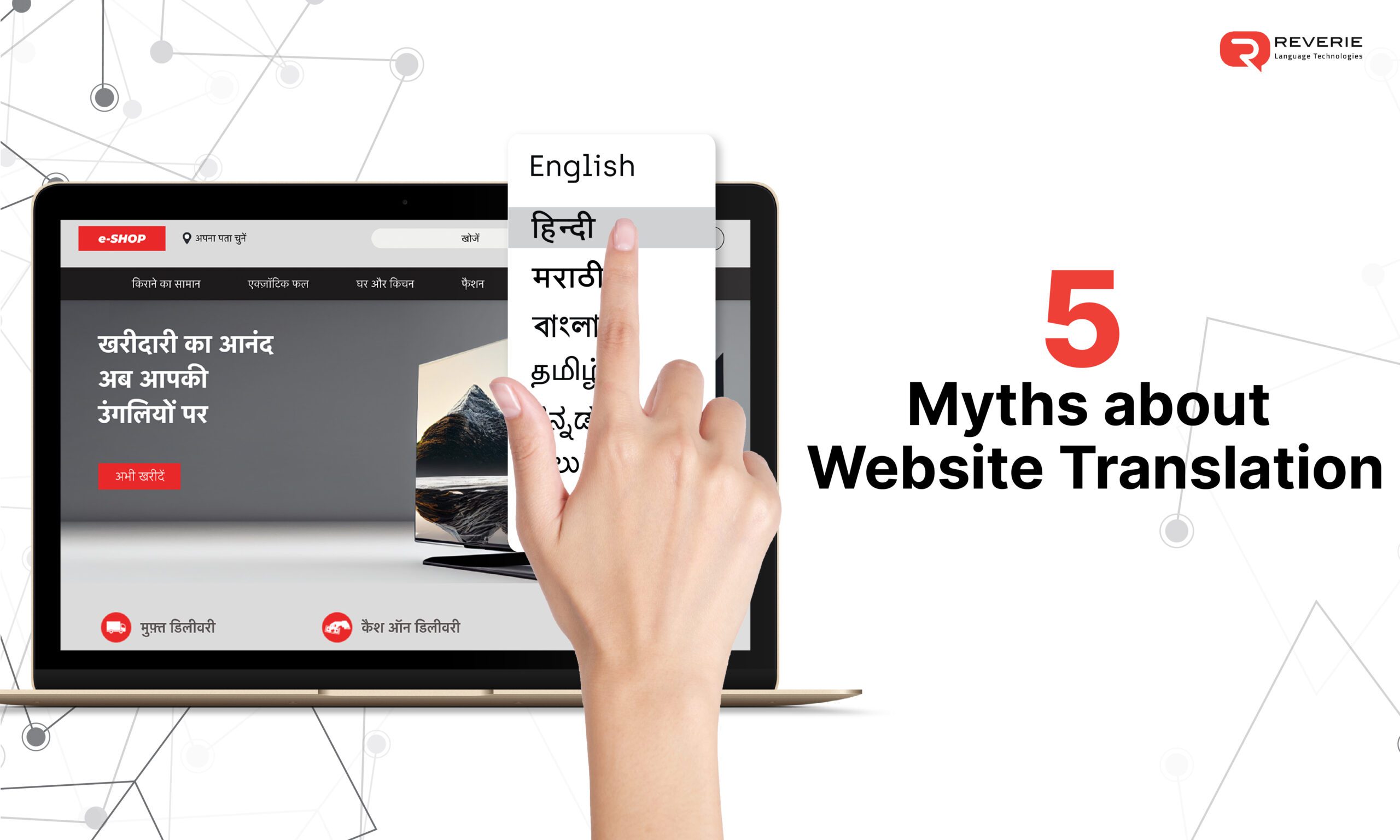Languages influence business. That’s not a myth. That’s already debunked. A case in point is the market size of language translation NLP (Natural Language Processing) in India is worth 79.26 million in 2023.
Marketers and business owners in India should be aware of the role the mother tongue plays in a customer’s decision-making. If they translate websites into customers’ native language, using an end-to-end website translation and localization platform, they can provide more value.
Myths about translating websites are obstacles that keep businesses from expanding to different markets that are well within their reach. Even if translating websites provides benefits such as an increase in traffic, engagement, and revenue, and saving 80% in manual effort, companies choose not to pursue website translation services because of certain misconceptions.
Today Reverie is determined to debunk 5 myths about website translation. Most of these myths are a result of the need for more information. Let’s look at them more closely.
Debunked Myths About Website Translation
- Multilingual SEO is Difficult
The myth that there’s no SEO optimization for a translated website is fundamentally flawed. In reality, SEO is equally critical for translated content, as search engines need to understand and index the information in different languages. Out of the 760 million active internet users in India, more than 400 million are from rural areas. The highest number of internet users in terms of language is Hindi, followed by Tamil, and Marathi. This requires search engines to index content of different languages so the information reaches the user.
- Website Translation Tool is Complicated
This is 100% false or you might have encountered a translation management system that has left this impression on you. When you realize just how simple managing a website translation is, you will wonder, why you have not done this sooner. There are complicated elements in translation management tools. These include a lack of end-to-end management, enabling sub-directories for multilingual SEO, limited translation methods, and analytics management. Website translation platforms such as Anuvadak help you manage all this. Businesses can translate, manage, optimize, and launch their multilingual website in real-time without any coding experience or needing any help from the development department making your life simpler.
- Free Translation Tools Are As Good As Paid Translation Tools
The most important benefit a paid translation tool provides apart from multilingual SEO, different translation methods and end-to-end management is data security. Many people don’t think twice before using free translation tools on the internet but what they don’t realize is that when they enter their data for translation, it’s publicly available.
To translate websites, paid translation services prioritize robust security measures, safeguarding data against potential breaches. Its comprehensive data security features ensure that the data provided by the customer is protected and secured in a certified environment. In the realm of business, where confidentiality is important, opting for a paid translation tool ensures a higher level of protection for translation.
- Website Translation is Only for Big Businesses
This myth seems to be born from the idea that SMEs (Small and Medium Enterprises) only operate in a smaller market. But within a multilingual environment such as India and given how eCommerce has flourished in the country, website translation has become a necessity for all types of businesses, big or small. Smaller businesses can leverage translation to connect with customers with different mother tongues, tap into new markets, and cultivate a broad user base. Breaking free from the misconception that website translation is solely for corporate giants opens doors for businesses of all sizes to thrive in an increasingly interconnected and multilingual digital environment.
- Website Translation is a One-time Task
Once the website is translated, there’s no further translation required. This is not true. Regular updates, product launches, and changes in industry terminology may require ongoing translation efforts. Website content is dynamic, and businesses frequently update their websites to reflect changes in products, services, promotions, and industry trends. A website often has dynamic content such as blogs or news articles. An AI-powered website translation tool keeps the translations aligned with the current terminologies which ensures your website reflects the latest industry standards and communicates effectively with native speakers in different regions. Another benefit of dynamic website translation is it helps with seasonal promotions, holiday messages, or special events that may not be relevant year-round. Translating and updating this content as needed helps maintain relevance with the local audience.
Click Here to Read Why to Choose Website Localization Over Website Translation
The Evolving Landscape of Website Translation
With the advancements in artificial intelligence and machine learning, website translation has become more efficient and accurate than ever before. One of the major advancements in translation technology is Neural Machine Translation (NMT). It is a type of machine translation that uses artificial neural networks to analyze vast amounts of content and generate more natural translations, making them almost indistinguishable from human translations. Although it cannot entirely replace human translators, Neural Machine Translation serves as a crucial tool to enhance the speed and efficiency of website translations.
Language technologies such as Reverie, integrate this NMT technology with the expertise of their human translators, striking a balance between the capabilities of artificial intelligence, machine language, and the nuanced understanding of human translators to deliver top-quality translations that resonate with target audiences.
Reverie’s End-to-end Language Technologies Solutions
Reverie is here to help at each stage of the set-up process and beyond. Allowing your business to focus on delivering multilingual content that is not just accurate but also authentic. For over a decade, Reverie has been working towards creating language equality over the internet. We have been helping enterprises expand with our translation API to reach their target audience effortlessly. You can launch your multilingual website with ease using Anuvadak. It’s our end-to-end website localization and translation platform. It helps give you a faster go–to–market time, cutting localisation costs by 60% and TAT by 40%; now.
With Reverie’s multilingual support and automated translation processes, improve your customer experiences and increase the efficiency and productivity of your enterprises.



